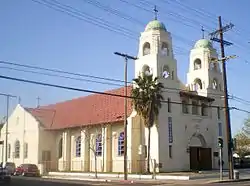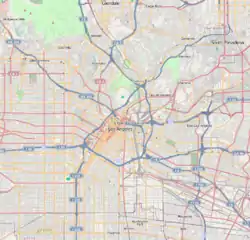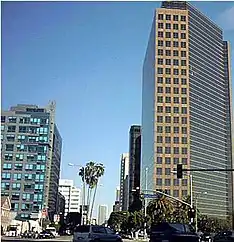Byzantine-Latino Quarter | |
|---|---|
 | |
 Byzantine-Latino Quarter Location within Central Los Angeles | |
| Coordinates: 34°02′50″N 118°18′00″W / 34.047232°N 118.300018°W | |
| Country | United States |
| State | California |
| County | Los Angeles |
| City | Los Angeles |
| Time zone | UTC-8 (PST) |
| • Summer (DST) | UTC-7 (PDT) |
| Zip Code | 90006 |
| Area code | 323 |
The Byzantine-Latino Quarter is a neighborhood in Central Los Angeles.
History
.JPG.webp)
The Byzantine-Latino Quarter, alternately referred to as the "BLQ",[1] was originally developed as "Pico Heights" in 1886 by the Electric Railway Homestead Association. A fashionable community of stately Craftsman homes and wealthy families, the area was annexed by the City of Los Angeles in 1896. By the 1920s, wealthy residents began moving out of the neighborhood to areas farther from the city center. During the 1930s and 1940s, the neighborhood became a destination for European immigrants.[2] The neighborhood was known as “Greek Town” for its concentration of Greek residents and businesses.[3] The Greek community was centered primarily around Pico and Normandie, adjacent to the St. Sophia Greek Orthodox Cathedral, which opened in 1952. During the 1970s, large numbers of Mexican immigrants settled in the neighborhood. In the 1980s, Central American immigrants primarily from El Salvador, Guatemala, and Honduras moved in.[2]
During the 1990s, local residents, community activists, faith leaders, and business owners formed a coalition and developed a community plan to revitalize the neighborhood. They wanted a name for the neighborhood, separate and distinct from the Pico-Union district. Instead of resurrecting the neighborhood's historic name, they proposed a new name: the Byzantine-Latino Quarter.[2]
In 1997, the area was designated the “Byzantine-Latino Quarter” by the California State Assembly and the Department of Transportation installed street markers.[4]

.jpg.webp)
Geography
The Byzantine-Latino Quarter is roughly bounded by 11th Street on the north, Venice Boulevard on the south, Hobart Boulevard on the west and Alvarado Street on the east.[5]
Business Improvement District
In 2003, the Byzantine-Latino Quarter Business Improvement District (BLQ BID), was approved and adopted by the Los Angeles City Council.[6] It was developed in conjunction with LANI (Los Angeles Neighborhood Initiative).[7] The BID is responsible for maintenance of the large neon sign (which reads Byzantine Latino-Quarter) that sits on the roof of a building on Pico Boulevard and Normandie Avenue.[8]
Education
Schools operating within the boundaries of the Byzantine-Latino Quarter are:
- Bishop Conaty-Our Lady of Loretto High School - 2900 Pico Boulevard
- The Jane B. Eisner Middle School - 2755 W. 15th Street
Landmarks and attractions
Events
References
- ↑ Arnold, Shayna Rose (June 10, 2009). "Hey Conan, Welcome to L.A.!". Los Angeles Magazine. Retrieved 15 March 2022.
Cruise on down to the BLQ (that's the Byzantine-Latino Quarter) on Pico Boulevard...
- 1 2 3 "How a Neighborhood Disappears: The Life and Death of Pico Heights". KCET.org. Retrieved 15 March 2022.
Instead of resurrecting the neighborhood's historical name, they decided to invent a new name: the Byzantine Latino Quarter.
- ↑ Levin, Rachel (February 10, 2009). "Neighborhoods: Byzantine-Latino Quarter". Retrieved 15 March 2022.
known as "Greek Town" for its concentration of Greek residents and businesses, community groups designated the area the "BLQ" in 1997..
- ↑ Usher, Nikki (August 12, 2004). "Where Spanakopita Rubs Elbows With Chile Relleno". Retrieved 15 March 2022.
The state Assembly officially designated the area the "Byzantine-Latino Quarter" in 1997 and the Department of Transportation erected street markers in the area.
- ↑ Hansen, Barbara (September 12, 1999). "The Next Fusion Cuisine? : At St. Sophia's festival this year, Greek and Mexican flavors intermingle". Los Angeles Times. Retrieved 15 March 2022.
The area--roughly from 11th Street south to Venice Boulevard and from Hobart Boulevard east to Alvarado Street--is known as the Byzantine Latino Quarter
- ↑ "Our History". Byzantine Latino Quarter Pico BID. Retrieved 15 March 2022.
- ↑ "Business Improvement District (BID) Management: Byzantine-Latino Quarter Pico BID". LANI.org. Retrieved 15 March 2022.
- ↑ "2012 Annual Report Byzantine Latino Quarter-Pico Boulevard Business Improvement District" (PDF). LACity.org. p. 16. Retrieved 15 March 2022.
- 1 2 Usher, Nikki (August 12, 2004). "Where Spanakopita Rubs Elbows With Chile Relleno". Retrieved 15 March 2022.
The churches -- St. Sophia and St. Thomas the Apostle -- form the backbone of the neighborhood..
- ↑ "About Us". LAGreekFest.com. Retrieved 15 March 2022.
The festival brings together the community of the Byzantine-Latino Quarter, people from all over downtown Los Angeles and Southern California.
- ↑ Shatkin, Elena (September 4, 2008). "Where you can be Greek for a day". Retrieved 15 March 2022.
the neighborhood was designated by the city as the Byzantine-Latino Quarter
